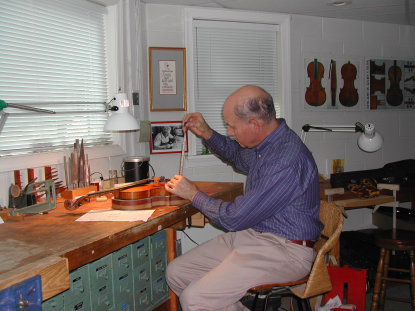In addition to making my own instruments, I am actively involved in research of great instruments of the past.
Graduation Patterns: I
have worked with Jeff Loen, a maker and researcher in Seattle, Washington, to collect and analyze thickness graduation data for fine
violins, violas, and cellos. Jeff and I have published one article in The Strad in December 2002 on thickness patterns in Stradivari
instruments and another, co-authored with Terry Borman, for instruments of Guarneri del Gesu in September 2005. Additional book-length
manuscripts have been completed and are awaiting publication, including a book featuring fine instruments from the National Music
Museum in South Dakota.
The maps are prepared from thickness measurements such as those I did for the Testore violin above, using
a sophisticated computer mapping program. For more information, or to purchase maps of this or many other instruments, contact Jeff
Loen at
LoenViolin@aol.com.
The Size and Position of Cremonese f-holes--I have intensively investigated the size and position of f-holes on classic Cremonese
violins, violas, and cellos. After much effort, I believe that I can offer a plausible reconstruction of the system used by those
great masters to determine the size and position of the f-holes. This system appears in an abbreviated form in the December 2004 and
January 2005 issues of The Strad.
For an expanded version of “The Cremonese System for Positioning the F-Holes,”
The Strad, December
2004, Click
HERE.
For an expanded version of “How Stradivari Positioned the F-Holes,”
The Strad, January 2005, Click
HERE.
Both of
these files are in .pdf format and require you to have the Adobe Acrobat Reader. If you do not have the Reader, you can get it as
a free download from the Adobe website at
www.Adobe.com.
I am currently preparing “The Cremonese System for Positioning the f-holes:
a Plausible Re-creation.” This book-length manuscript provides more details about the system, the variants associated with different
makers, and many more examples, especially the application of the system to the larger instruments. You may contact me directly if
you would like to be notified when it is available.
Wolf-tone Suppression: The tailpiece vibrates in several different modal patterns
and frequencies when the instrument is played. I have investigated the possibility of adjusting the tailpiece to use a natural tailpiece
mode to suppress the wolf-tone.
Testing the Quality of Wood: Oliver Rodgers developed a program to test wood flitches. Based on simple
measurements and taptones, the program will calculate the three basic wood stiffnesses and the density of the sample. I have re-written
Oliver’s original FORTRAN program as an Excel spreadsheet. Instructions for use and simple examples of the results are included. Please
note that recently increased security precautions will normally disable the macros when you open the spreadsheet. You may have to
explicitly allow the macros to run. Click
HERE to download a copy.
Wood Density: Sometimes it is convenient to find the density
of a single flitch (before joining, for example). This simple spreadsheet will do that. Click
HERE.
Cremonese Acoustical Design: I
concluded my papers on the Cremonese system for positioning the f-holes by noting that I had resolved one mystery but created another:
what is the role of the pins in the Cremonese system? In particular, how do they relate to the overall design? In recent years I have
investigated what I call the “Principles of Cremonese Acoustical Design”. At this point I believe that I can explain the principles
that relate physical design to acoustical design. Not surprisingly, the positions of the pins play a role beyond merely mechanical.
I have begun to write a paper describing my theories and relevant evidence.
Other research in progress: the design of arching,
the interaction of arching and graduation patterns, and the interaction of air and wood modes.
Here I am using a Hacklinger gauge to measure the thicknesses of the top plate of a violin by Carlo Antonio Testore of 1748.


